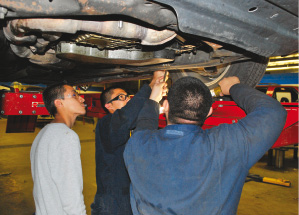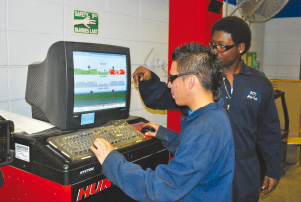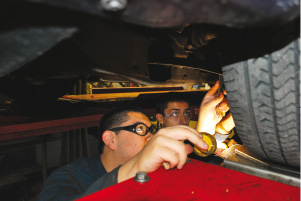
By Leslie Collins
Northeast News
November 9, 2011
Manual Career Tech’s auto shop was awash with activity. Some students stood at a computerized four-wheel alignment system while others performed oil changes or installed brake lines and more.
“I wanted to take this class because all my life I’ve been around cars. I wanted to see if I could learn more and how to fix them to help my father fix his cars so we don’t have to waste that much money on them,” East High School senior Alberto Muñoz said.
Muñoz recalled visiting a family friend’s garage weekly to work on cars and how his father took him and his brother to car shows.
“I would see all these different cars and how they fixed the engines and it just stuck with me all my life,” he said.
Thirty Kansas City Public Schools’ students are enrolled in the automotive technology program, which is offered as a morning or afternoon session five days a week.
“We give students real experiences, real hands-on experiences in various career pathways,” said Jack Bitzenburg, director of career and technical education at Manual Career Technical Center. “They’re not just studying theory. They’re applying theory in a project-based teaching and learning environment.”
Bitzenburg cut through the stereotype that those attending technical schools are simply not fit for college or as intelligent.
“With any new car, if it’s newer than three or four years old, there’s more computer memory in that car than in your Macbook Pro,” he said in reference to this reporter’s laptop. “Would you want a kid working on your car who couldn’t do anything else and go to college? I think not.”
A number of technical education careers earn higher salaries than college graduates, he said.
A state-of-the-art shop
With pride, Geoffrey Mellott looked around his auto shop.
“There’s probably some independent shops out there that would be envious of the equipment we have,” the master mechanic and automotive technology program instructor said.
Muñoz agreed.
“It has more tools and efficiencies that most garages I’ve seen don’t have,” Muñoz said.
Mellott called the equipment “state-of-the-art” and said the Hunter computerized four-wheel alignment system is worth $60,000. The computerized brake lathe cost $13,000 and most tire dealers in the area are three generations behind the school’s Hunter Road Force wheel balancer, he said.
Asked what students learn in his class, Mellott listed several things, including safety, customer relations, employer expectations, teamwork, oil changes and minor service related to tune ups, belts, hoses, basic alignment, wheel balance, flat tires, among others.
In today’s computer driven world, manual labor is still a must, he said.
“You still have to have somebody that’s going to get greasy and fix a car. I’ve never seen a computer balance tires on a car,” Mellott said.
For hands-on learning, students work on school district employee vehicles and also serve a small public clientele base.
“My favorite part of this whole section is working on the tail lights and brakes. We’ve been working on that for so long and I really like to do things like that,” East High School junior Shane Polk said. “I like a little bit more challenge and a little bit more hard work.”
“I’d never seen equipment like this or used equipment like this,” Northeast High School junior Rosemberg Ramirez said. “It was a new experience for me, but a lot of fun.”
While the class is about automotive technology, Mellott isn’t solely focused on cars. He also teaches life lessons and gives hugs when they’re needed.
“I have three letters I put in their heads. That’s MMA. It’s maturity, motivation and ambition. There’s customer relations. I try real hard with that and make sure they’re polite.”
He also stresses dependability and professionalism, he said.
“I think he’s great,” Northeast High School junior Diego Calderon said of Mellott. “He’s funny and mixes everything. He makes it interesting. He just knows how to teach.
“It seems like he gets us and he knows when we get bored and he knows how to change it.”
“He’s easy to get along with,” Ramirez added.
Muñoz praised Mellott’s patience and said he’s someone who will figure out another way to explain a concept if you don’t understand it the first time.
In addition to mechanic skills, Mellott is preparing his students to be ready for anything.
He used an example of a Taurus that recently came in the shop for an alignment, but the students soon discovered an antifreeze leak.
“You have to be prepared for the unexpected,” he said. “You can’t just say we’re going to do an alignment on this and then ignore the antifreeze leak. The students will have to know what to do about that and how to handle that.”
Asked what he hopes his students take away from the course, he said, “I hope they take away a respect of the world of work and a respect for the people that have tried to help them and direct them. And I hope they make a success out of themselves.”

















